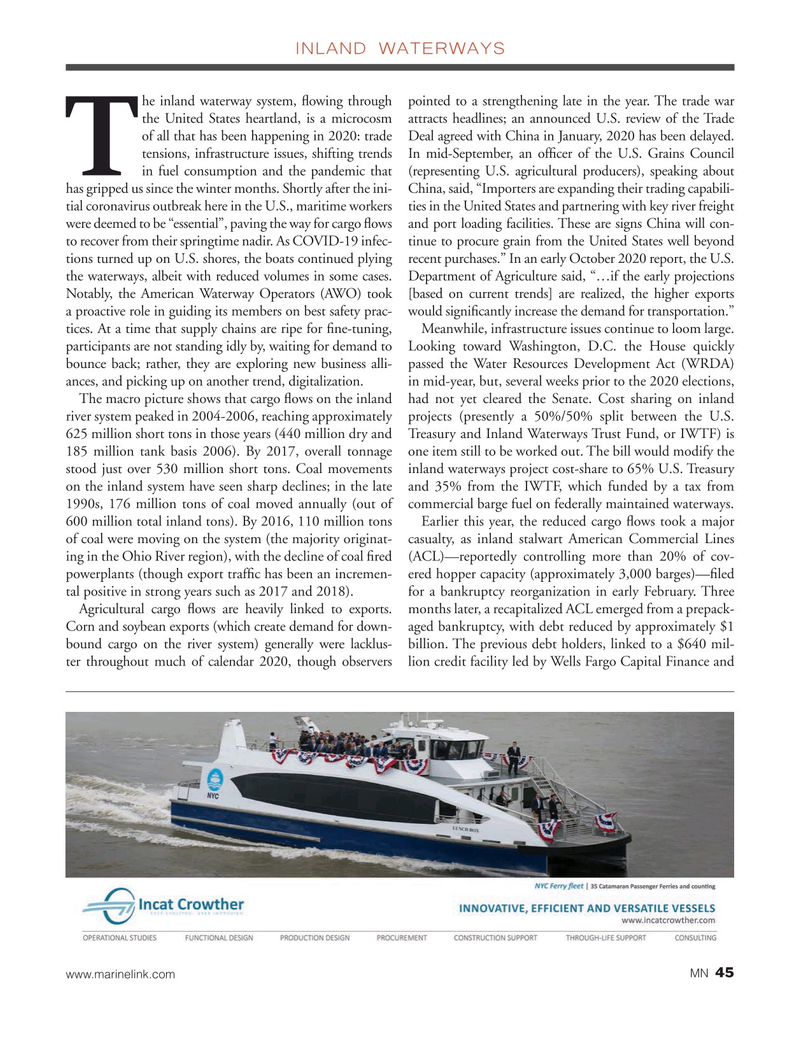
Page 45: of Marine News Magazine (November 2020)
Workboat Annual
Read this page in Pdf, Flash or Html5 edition of November 2020 Marine News Magazine
INLAND WATERWAYS he inland waterway system, ? owing through pointed to a strengthening late in the year. The trade war the United States heartland, is a microcosm attracts headlines; an announced U.S. review of the Trade of all that has been happening in 2020: trade Deal agreed with China in January, 2020 has been delayed. tensions, infrastructure issues, shifting trends In mid-September, an of? cer of the U.S. Grains Council in fuel consumption and the pandemic that (representing U.S. agricultural producers), speaking about
T has gripped us since the winter months. Shortly after the ini- China, said, “Importers are expanding their trading capabili- tial coronavirus outbreak here in the U.S., maritime workers ties in the United States and partnering with key river freight were deemed to be “essential”, paving the way for cargo ? ows and port loading facilities. These are signs China will con- to recover from their springtime nadir. As COVID-19 infec- tinue to procure grain from the United States well beyond tions turned up on U.S. shores, the boats continued plying recent purchases.” In an early October 2020 report, the U.S. the waterways, albeit with reduced volumes in some cases. Department of Agriculture said, “…if the early projections
Notably, the American Waterway Operators (AWO) took [based on current trends] are realized, the higher exports a proactive role in guiding its members on best safety prac- would signi? cantly increase the demand for transportation.” tices. At a time that supply chains are ripe for ? ne-tuning, Meanwhile, infrastructure issues continue to loom large. participants are not standing idly by, waiting for demand to Looking toward Washington, D.C. the House quickly bounce back; rather, they are exploring new business alli- passed the Water Resources Development Act (WRDA) ances, and picking up on another trend, digitalization. in mid-year, but, several weeks prior to the 2020 elections,
The macro picture shows that cargo ? ows on the inland had not yet cleared the Senate. Cost sharing on inland river system peaked in 2004-2006, reaching approximately projects (presently a 50%/50% split between the U.S. 625 million short tons in those years (440 million dry and Treasury and Inland Waterways Trust Fund, or IWTF) is 185 million tank basis 2006). By 2017, overall tonnage one item still to be worked out. The bill would modify the stood just over 530 million short tons. Coal movements inland waterways project cost-share to 65% U.S. Treasury on the inland system have seen sharp declines; in the late and 35% from the IWTF, which funded by a tax from 1990s, 176 million tons of coal moved annually (out of commercial barge fuel on federally maintained waterways.
600 million total inland tons). By 2016, 110 million tons Earlier this year, the reduced cargo ? ows took a major of coal were moving on the system (the majority originat- casualty, as inland stalwart American Commercial Lines ing in the Ohio River region), with the decline of coal ? red (ACL)—reportedly controlling more than 20% of cov- powerplants (though export traf? c has been an incremen- ered hopper capacity (approximately 3,000 barges)—? led tal positive in strong years such as 2017 and 2018). for a bankruptcy reorganization in early February. Three
Agricultural cargo ? ows are heavily linked to exports. months later, a recapitalized ACL emerged from a prepack-
Corn and soybean exports (which create demand for down- aged bankruptcy, with debt reduced by approximately $1 bound cargo on the river system) generally were lacklus- billion. The previous debt holders, linked to a $640 mil- ter throughout much of calendar 2020, though observers lion credit facility led by Wells Fargo Capital Finance and 45 www.marinelink.com MN

 44
44

 46
46
